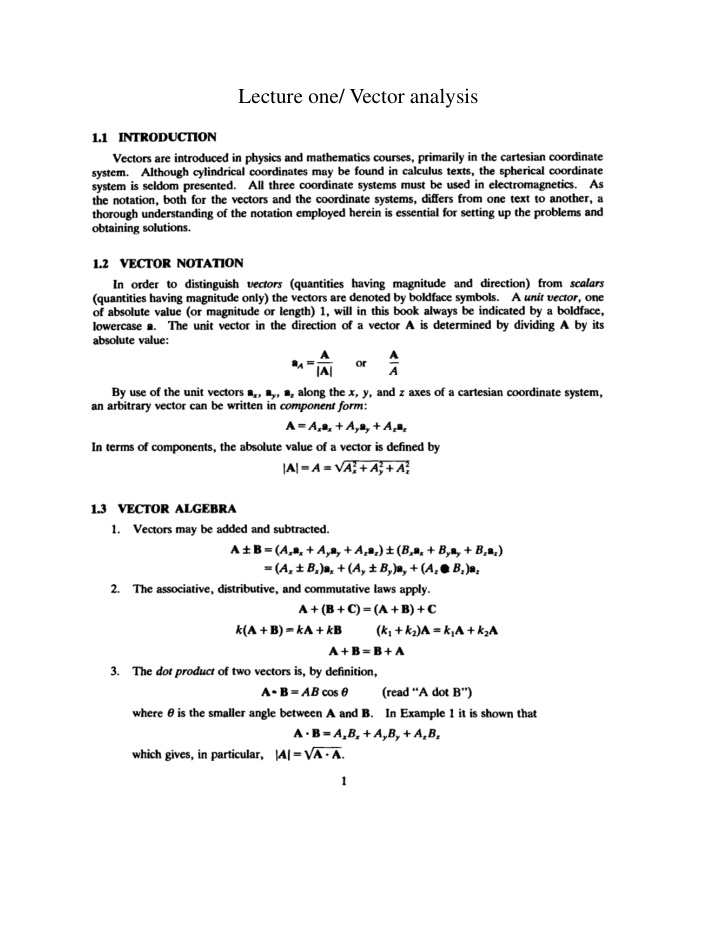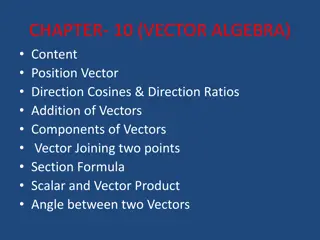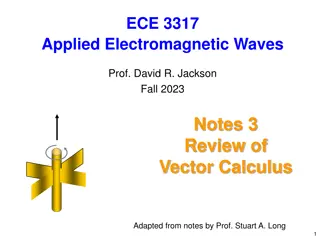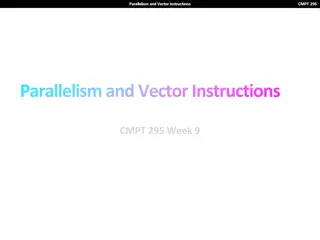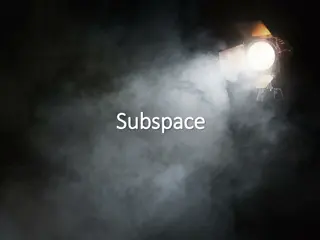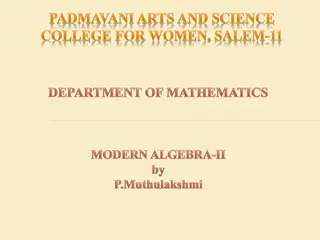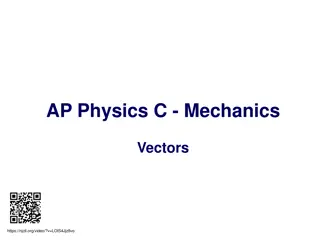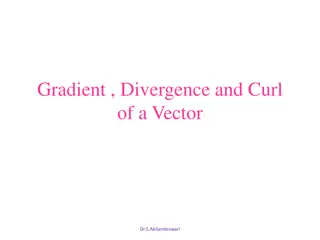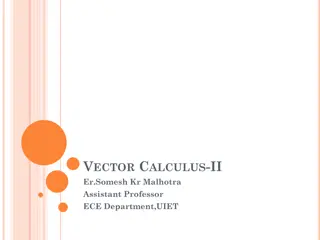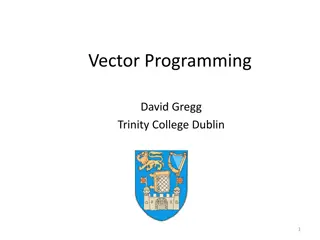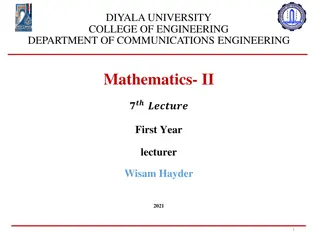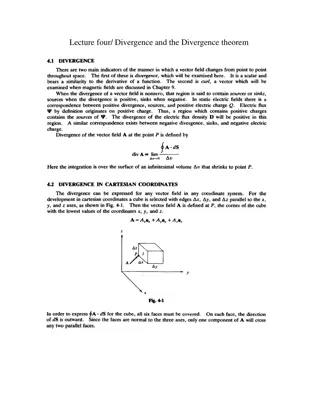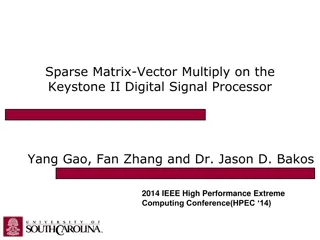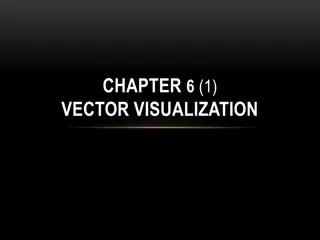Vector Analysis: Laws and Examples
Illustrating the distributive and scalar multiplication laws of vector analysis, this content delves into dot and cross products, along with example calculations. It also explores coordinate systems, highlighting the significance of cartesian, cylindrical, and spherical systems in solving problems with symmetry.
Download Presentation

Please find below an Image/Link to download the presentation.
The content on the website is provided AS IS for your information and personal use only. It may not be sold, licensed, or shared on other websites without obtaining consent from the author.If you encounter any issues during the download, it is possible that the publisher has removed the file from their server.
You are allowed to download the files provided on this website for personal or commercial use, subject to the condition that they are used lawfully. All files are the property of their respective owners.
The content on the website is provided AS IS for your information and personal use only. It may not be sold, licensed, or shared on other websites without obtaining consent from the author.
E N D
Presentation Transcript
2 VECfOR ANALYSIS (OIAP. 1 EXAMPLE 1. lbe dot product obeys the distributive and scalar multiplication laws A (B+C) A 8 +A C A kB = k(A B) This being the case, A 8-=(A..a..+ A,.a,.+ A ,a.) (B..a..+ B,.a,.+ B,a.) - A..B..(a.. a..)+ A,.B,.(a,. a,.)+ A,B.(a.. a.) +A..B,.(a. a,.)+ +A.B,.(a. a,.) However, a. a..= a,. a,.= a. a.= 1 because the cos 8 in the dot product is unity when the angle is zero. And when 8=90", cos 8 iszero; hence all other dot products of the unit vectors are zero. Thus A 8 = A,.B..+A,.B,.+A,B. 4. The cross product of two vectors is, by definition, (read ..A cross B") A X B = (ABsin 8)a,. where 8 is the smaller angle between A and B, and a, is a unit vector normal to the plane determined by A and B when they are drawn from a common point. There are two normals to the plane, so further specification is needed. The normal selected is the one in the direction of advance of a right-hand screw when A is turned toward B {Fig. 1-1). Because of this direction requirement , the commutative cross product; instead, law does not apply to the A X B = - B X A tlx..1-1 Expanding the cross product in component form, A X B = (A...a..+A,.a,.+Azaz) X (B..a...+ B,.a,.+Bzaz) =(A,.Bz - AzB,.)a.., +(AzB..- A ..B,)a...+(A_.B...-A,.B_.)a, which is conveniently expressed as a determinant: ... A X B = A_.. B. .
3 VECfOR ANALYSIS CHAP. 1] EXAMPLE 2. Given A ""2a..+ 4a,.- and B = =a..- a,.. find A B and A x B. A B=(2)(1)+(4)(- 1)+(- 3)(0)=- 2 a.. a,. 2 1 - 1 0 a. - 3 =-3a..- 3a,.- 6a. AXB-= 4 1.4 COORDINATE SYSTEMS A problem which has cylindrical or spherical symmetry could be expressed and solved in the familiar cartesian coordinate system. However, the solution would fail to show the symmetry and in most cases would be needlessly complex. 'Iberefore, throughout this book, in addition to the cartesian coordinate system, the circular cylindrical and the spherical coordinate systems will be used. AU three will be examined together in order to illustrate the similarities and the differences. A point Pis described by three coordinates, incartesian (x, y, z), in circular cylindrical(r, q,, z), and in spherical (r, 6, ,P), as shown in Fig. 1-2. The order of specifying the coordinates is important and should be carefully followed. The angle q, is the same angle in both the cylindrical and spherical systems. But, in the order of the coordinates, tPappears in the second position in cylindrical, (r, q,, z), and the third position in spherical, (r, fJ,q>). both cylindrical and spherical for two quite different things. the distance from the z axis in a plane normal to the z axis, while in the spherical system r measures the distance from the origin to the point. It should be clear from the context of the problem which r is intended. The same symbol, r, is used in In cylindrical coordinates r measures z z z r P (r, . z) I: z - + - - - - P(x,y , z) IIz .._'7'"""_ I , , ;. /J "x /-- y +- Y __ y X X (o)Cartesian (c) Spherical (b}Cylindrical fl&.1 1 A point is also defined by the intersection of three orthogonal surfaces, as shown in Fig. 1-3. cartesian coordinates the surfaces are the infinite planes x = const., y = const., const. In cylindrical coordinates, z =const. const. is a half plane with its edge along the z axis; r = const. is a right circular cylinder. These three surfaces are orthogonal and their intersection locatespoint P. In spherical coordinates. const. is the same half plane as in cylindrical; r=const. origin; is a right circular cone whose axis is the z axis and whose vertex is at the origin. Note that 8 is limited to the range 0s 6 s rr. Figure 1-4 shows the three unit vectors at point P. fixed directions, independent of the location of P. in the case of a,). Each unit vector is normal to its coordinate surface and is in the direction in which the coordinate increases. Notice that all these systems are right-handed: In and z = is the same infinite plane as in cartesian; q,= q,= is a sphere with its center at the 6=const. In the cartesian system the unit vecton have This is not true for the other two systems (except a,.x a.,= , ....x a,.=a,
VECTOR ANALYSIS 4 (CHAP. 1 z z z 6"' const. r = const. z = const. 1 - - - . , _ y X X : : const. (a) Cartesian (b)Cylindrical (c) Spherical f'll 1-3 1be component forms of a vector in the three systems are A= A, a, + Ayay +Az z A= A,.a, +A +A,az A= +A.,.a. It should be noted that the components A, , A,, A etc., are not generally constants but more often are functions of the coordinates in that particular system. (cartesian) (cylindrical) +A6a6 A,.a, (spherical) z z z - y X X (c)Spherical (b) Cylindrical (a)Cartesian FIJ. 1-4 1.5 DIFFEREN11AL VOLUME, SURFACE, AND LINE ELEMENTS There are relatively few problems in electromagnetics that can be solved without some son of integration-along a curve, over a surface, corresponding differential elements must be clearly understood. When the coordinates of point P are expanded to (x +dx,y +dy, z +dz) or (r +dr, 4 > + dcp,z +dz) or (r +dr, 8 + d8, cp+dcp), a differential volume dv is formed. To the first order in infinitesimal quantities the differential volume is, in all three coordinate systems, a rectangular box. The value of dv in each system is given in Fig. 1-5. or throughout a volume. Hence the
